|
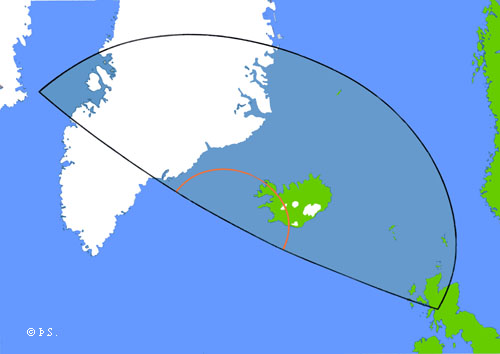 |
|
Figure 1. The path of the annular eclipse. The shadow traverses the area between the black, curved lines from 03:45 UT to 04:31 UT. The red curve shows where an observer must be located to see the moon pass exactly over the centre of the sun's disc. |
The annular eclipse approaches Iceland from the southeast, the edge of the shadow crossing the country in only 7 minutes. The ground velocity of the shadow is 1.1 km per second or nearly 4000 km/h. The shadow departs the country less than 11 minutes after first touching it. By shadow is here meant the "transumbral" shadow where an annular eclipse can be seen, but a partial eclipse is visible from a much wider zone.
Dr. Andrew Sinclair, formerly of the Royal Greenwich Observatory and one-time Head of H.M. Nautical Almanac Office, has made an animated illustration of the eclipse as it moves across the earth's surface. The animation appears on Sinclair's website and is reproduced here with the author's permission.
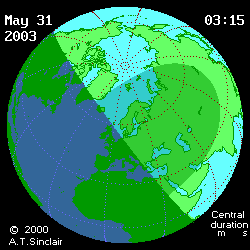 |
Figure 2. The large shadow moving from southeast to northwest indicates the partial eclipse, while the smaller area, red and elongated, marks the annular eclipse. It should be noted that in reality there are no sharp contours within the moon's shadow, only a gradual darkening from the outermost limit of partial eclipse towards the area of annular eclipse, where the darkening is uniform. |
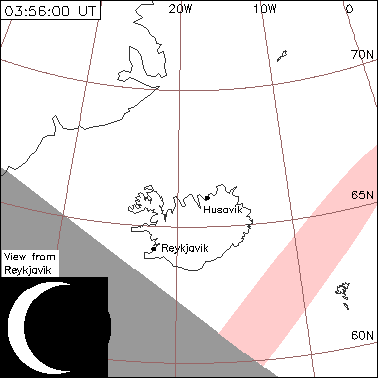 |
Figure 3. This animation, also by Sinclair, is designed to show how the annular eclipse moves across Iceland. The inset shows the sun as it would appear from Reykjavik if there were no mountains (see below). |
The accompanying table gives the times of the eclipse at different places in Iceland. The eclipse takes place so early in the morning that the sun is very low in the sky, especially in the southwestern part of the country, where it does not rise until after the eclipse has begun. In the northeast, the sun will be somewhat higher, making it possible to observe the eclipse from the very beginning. The moon approaches the sun from the right and is first seen near 3 o'clock on the sun's disc. The map below shows in which half of Iceland this beginning can be seen. The dividing line crosses the country from southeast to northwest.
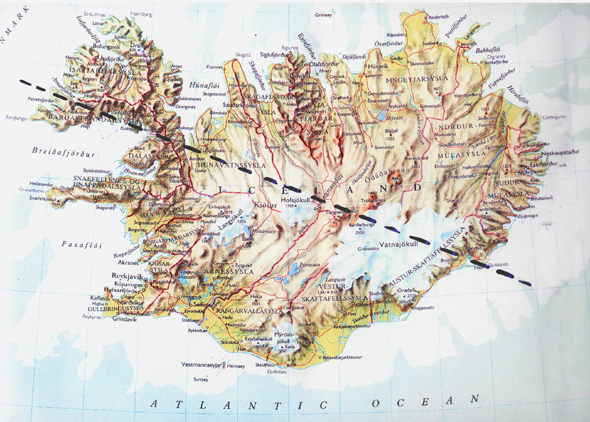
| Figure 4. The map shows in which part of Iceland the sun has risen when the moon first appears on the sun's limb. This is true for all locations above the broken line. Below the line, the beginning of the partial phase cannot be seen, but by the time of the annular phase, the sun is above the horizon everywhere in the country. The word horizon, as used here, refers to the celestial horizon which is level with the eye, disregarding features of landscape which define the visible horizon.. |
At the beginning of the eclipse the sun will be 1.9║ above the horizon at Fontur, the extreme point of Langanes in the northeast. At Rifstangi, the northernmost point of Iceland, the sun's altitude will be 1.8║. At Grimsey, an island straddling the Arctic Circle, its altitude will be 1.5║. To see the beginning of the eclipse from the neighbourhood of Reykjavik, the observer would have to be in an aeroplane flying above 2000 m.
The annular phase of the eclipse should be visible from any part of Iceland, provided that the sun is not obscured by clouds or mountains. The mountain Esja will prevent observations from Reykjavik proper, but on the Seltjarnarnes peninsula, to the west of the city, the sun should be just visible over the western shoulder of the mountain. At Akureyri, the largest town in northern Iceland, a nearby mountain (Valaheii) will obstruct the view from most of the town.
As already stated, the sun does not quite disappear behind the moon. The moon will cover 94% of the sun's diameter and 88% of the area of its disc. The human eye adjusts itself to the diminishing sunlight so that the darkening of the landscape will not be all that obvious. The same can be said of the sky, which will not become dark and the stars will not appear. The brightest planet, Venus, will probably be visible, about 20║ to the right of the sun.
Although the sun will be low in the sky and most of its disc covered by the moon, it will still be too bright for observation with unshielded eyes if the sky is clear and cloudless. It is therefore extremely important to protect the eyes when looking at the sun. If a specially designed solar filter is not available, an evenly exposed photographic film may be used, provided that it is sufficiently dark so that the observer can look at the sun without any discomfort. Black and white film is safer than colour film. Welder's glass is another possibility. If a telescope is used or a pair of binoculars, the safest method is to project the light onto a piece of paper and adjust the focus until the picture is sharp.
Most illustrations of this eclipse, including Fig. 1 above, show a curved line crossing Iceland. This line is the so-called central line which the axis of the moon's shadow traces out on the surface of the earth. An observer on this line will at some moment see the moon exactly in the middle of the sun's disc. Some authors have emphasized that the eclipse will be greatest along this line, implying that the observer should strive to be as close to it as possible. This is somewhat misleading. When the shadow is spread over a large area, as in this instance, the position of the observer relative to the central line is not at all critical. As can be seen from the table below, the duration of the eclipse is very nearly the same everywhere in Iceland, varying only from 3 minutes 34 seconds in the southeast to 3 minutes 37 seconds in the north and northwest. The appearance of the eclipsed sun is also much the same for all locations. Figure 5 shows the view from the vicinity of Reykjavik while Fig. 6 shows the view from the extreme northeast point of Langanes (Fontur).
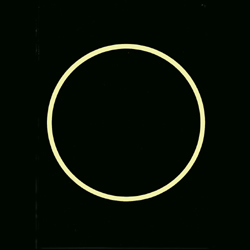 |
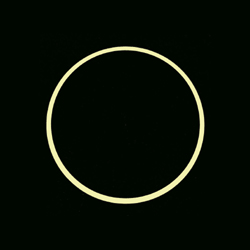 |
| Figure 5. View from near Reykjavik. |
Figure 6. View from Langanes (Fontur). |
As seen from near Reykjavik, the moon appears quite central while at Langanes,
which is farthest from the central line, a slight offset may
be discerned. More important is the fact that the sun is
considerably higher in the sky at Langanes,
making it easier to see the eclipse. When choosing a
place for observing, however, the weather is the overriding consideration. A weather description and
forecast may be found at the website of the Icelandic
Meteorological Office.
Annular and total eclipses of the sun
By a coincidence, the sun and the moon appear almost the same size in the sky. Whether the moon can cover the sun completely during a particular eclipse depends on how far away the sun and moon are at the time. The distances of these bodies from the earth vary to some extent. This is especially true of the moon, which can come as near as 356 000 km or be as far away as 407 000 km. On May 31, the moon will be 404 000 km from the earth, which is close to maximum distance. The moon will therefore appear distinctly smaller than usual in the sky and less able to cover the sun. The sun will also be farther away than average and thus appear slightly smaller than usual, but not so as to match the change in the apparent size of the moon. As a result, the moon cannot cover the disc of the sun. Its dark (umbral) shadow does not quite reach the earth's surface, passing by at a distance of 25 000 km. The axis of the shadow cone almost misses the earth, touching it only at the edge as seen from the moon (Fig. 7).
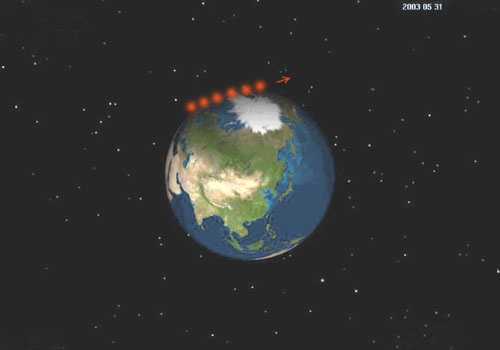 |
| Figure 7. The picture presents the earth as seen from the moon at the time of the eclipse (clouds are not shown!). The red dots mark the centre of the moon's shadow at certain intervals. The shadow moves from left to right, touching the earth's edge as seen from the moon. The picture was created by adding red markings to an illustration from the program Celestia. |
The transumbral (annular) shadow touches the earth for 46 minutes but the shadow axis, which traces out the central line, touches for only 12 minutes. The way the shadow falls on the edge of the earth, as seen from the moon, causes it to spread over a large area like an elongated ellipse, more than 1200 km in extent. If the shadow had passed across the centre of the earth as seen from the moon, it would have been only 170 km wide at the point of contact.
The number of annular eclipses visible from the earth as a whole averages about 77 per century. For total eclipses the number is approximately the same. Certain eclipses are seen as total from some locations and annular from others. Such cases (about 10 per century) are here counted as total eclipses. The number of eclipses to be expected at any given place depends on geographical latitude and can be up to twice as high in one place as in another. The Belgian mathematician Jean Meeus has made a thorough study of this question. According to his calculations we may expect, at the latitude of Reykjavik, a total eclipse once in 285 years and an annular eclipse once in 195 years. It should be emphasized that these are averages and the period between individual eclipses can vary widely. The last time an annular eclipse was seen in Iceland was in 1793, while the next one will be in 2048. The last total solar eclipse visible in Iceland took place in 1954 and the next one is expected in 2026.